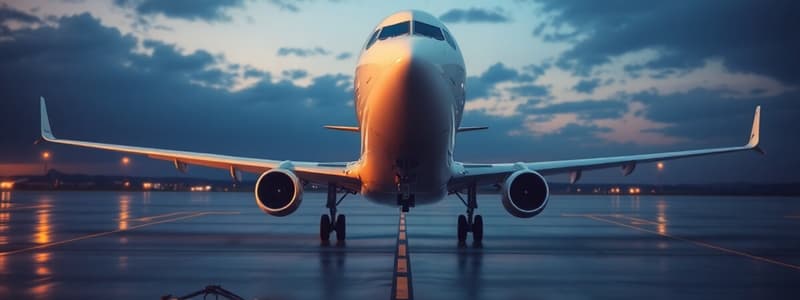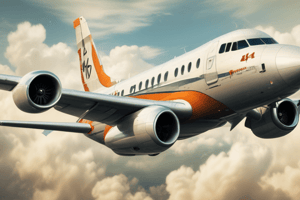Podcast
Questions and Answers
What should an applicant at Level 1 be able to do regarding the subject?
What should an applicant at Level 1 be able to do regarding the subject?
Which level requires an applicant to understand the theoretical fundamentals of the subject?
Which level requires an applicant to understand the theoretical fundamentals of the subject?
At which knowledge level is the applicant expected to provide a detailed description of the subject?
At which knowledge level is the applicant expected to provide a detailed description of the subject?
Which capability is attributed to Level 2 applicants?
Which capability is attributed to Level 2 applicants?
Signup and view all the answers
What distinguishes Level 3 knowledge from the other levels?
What distinguishes Level 3 knowledge from the other levels?
Signup and view all the answers
What type of knowledge is expected from a Level 1 applicant?
What type of knowledge is expected from a Level 1 applicant?
Signup and view all the answers
Which level is NOT required to have a general description ability using examples?
Which level is NOT required to have a general description ability using examples?
Signup and view all the answers
To which knowledge level is the requirement to read and understand sketches and drawings particularly important?
To which knowledge level is the requirement to read and understand sketches and drawings particularly important?
Signup and view all the answers
What is required of Air Operator's Certificate (AOC) holders regarding aircraft operations?
What is required of Air Operator's Certificate (AOC) holders regarding aircraft operations?
Signup and view all the answers
What organization must AOC holders be approved as for continuing airworthiness management?
What organization must AOC holders be approved as for continuing airworthiness management?
Signup and view all the answers
What is included in the Annual Airworthiness Review?
What is included in the Annual Airworthiness Review?
Signup and view all the answers
What type of maintenance organization must be approved for Regular Public Transport (RPT) operators?
What type of maintenance organization must be approved for Regular Public Transport (RPT) operators?
Signup and view all the answers
What does Part 145 introduce in relation to aviation safety management?
What does Part 145 introduce in relation to aviation safety management?
Signup and view all the answers
Which principle is emphasized in the requirements of Part 145?
Which principle is emphasized in the requirements of Part 145?
Signup and view all the answers
Which categories are included in Part 66 licensing?
Which categories are included in Part 66 licensing?
Signup and view all the answers
Which statement about B1 and B2 licenses is true?
Which statement about B1 and B2 licenses is true?
Signup and view all the answers
What is the primary purpose of Advisory Circulars (ACs)?
What is the primary purpose of Advisory Circulars (ACs)?
Signup and view all the answers
Which aspect is NOT a focus of the Maintenance Regulations?
Which aspect is NOT a focus of the Maintenance Regulations?
Signup and view all the answers
What do CAAPs primarily relate to?
What do CAAPs primarily relate to?
Signup and view all the answers
How does CASA ensure compliance under CASR parts?
How does CASA ensure compliance under CASR parts?
Signup and view all the answers
Which sector does Part 21 impact the most?
Which sector does Part 21 impact the most?
Signup and view all the answers
What should ACs be read in conjunction with?
What should ACs be read in conjunction with?
Signup and view all the answers
What is required for an organization to gain approval under CASR parts?
What is required for an organization to gain approval under CASR parts?
Signup and view all the answers
Which of the following is NOT a function of CAAPs?
Which of the following is NOT a function of CAAPs?
Signup and view all the answers
What is the primary function of EASA?
What is the primary function of EASA?
Signup and view all the answers
What regulation sets common rules in the field of civil aviation within the EU?
What regulation sets common rules in the field of civil aviation within the EU?
Signup and view all the answers
Which of the following countries is NOT listed as having automatic acceptance of aircraft Type Certificates?
Which of the following countries is NOT listed as having automatic acceptance of aircraft Type Certificates?
Signup and view all the answers
What must applicants do to obtain a Type Acceptance Certificate (TAC) from CASA?
What must applicants do to obtain a Type Acceptance Certificate (TAC) from CASA?
Signup and view all the answers
What is meant by 'carry out maintenance' in the context of Part 66?
What is meant by 'carry out maintenance' in the context of Part 66?
Signup and view all the answers
Which authority is responsible for the aviation standards in France?
Which authority is responsible for the aviation standards in France?
Signup and view all the answers
What does EASA's standardisation and oversight function pertain to?
What does EASA's standardisation and oversight function pertain to?
Signup and view all the answers
Which document establishes the common rules in civil aviation for EASA member states?
Which document establishes the common rules in civil aviation for EASA member states?
Signup and view all the answers
What is the primary purpose of Part 147?
What is the primary purpose of Part 147?
Signup and view all the answers
What must a Maintenance Training Organisation (MTO) do to train aircraft maintenance engineers?
What must a Maintenance Training Organisation (MTO) do to train aircraft maintenance engineers?
Signup and view all the answers
Which license categories are aligned with type-rating training?
Which license categories are aligned with type-rating training?
Signup and view all the answers
What does CASA's agreement with the FAA promote?
What does CASA's agreement with the FAA promote?
Signup and view all the answers
What does the Bilateral Aviation Safety Agreement involve?
What does the Bilateral Aviation Safety Agreement involve?
Signup and view all the answers
Which organization is CASA partnered with under an arrangement similar to that with the FAA?
Which organization is CASA partnered with under an arrangement similar to that with the FAA?
Signup and view all the answers
Which of the following is NOT a component addressed by CASA and FAA's aircraft certification systems?
Which of the following is NOT a component addressed by CASA and FAA's aircraft certification systems?
Signup and view all the answers
Under what conditions can CASA approve Maintenance Training Organisations?
Under what conditions can CASA approve Maintenance Training Organisations?
Signup and view all the answers
What does an Avionic Line Replaceable Unit (LRU) require for installation?
What does an Avionic Line Replaceable Unit (LRU) require for installation?
Signup and view all the answers
Which of the following is NOT included as an example of avionics systems?
Which of the following is NOT included as an example of avionics systems?
Signup and view all the answers
What is one characteristic of an Avionic Line Replaceable Unit?
What is one characteristic of an Avionic Line Replaceable Unit?
Signup and view all the answers
Which specific type of maintenance is referred to as base maintenance?
Which specific type of maintenance is referred to as base maintenance?
Signup and view all the answers
How does an avionics system transfer data?
How does an avionics system transfer data?
Signup and view all the answers
Which of the following components is part of an aircraft's electrical system?
Which of the following components is part of an aircraft's electrical system?
Signup and view all the answers
What defines a component as an avionics system?
What defines a component as an avionics system?
Signup and view all the answers
What is a key feature of the components of an avionics system?
What is a key feature of the components of an avionics system?
Signup and view all the answers
Flashcards
Category A, B1, B2 and C Aircraft Maintenance Licence
Category A, B1, B2 and C Aircraft Maintenance Licence
Different levels of aircraft maintenance licenses, each with varying knowledge requirements.
Knowledge Levels (1, 2, 3)
Knowledge Levels (1, 2, 3)
Indicators used to define the complexity and depth of knowledge required for aircraft maintenance license categories.
Level 1 Knowledge
Level 1 Knowledge
Basic familiarity with a subject's elements; ability to describe it in general terms using common words and examples.
Level 2 Knowledge
Level 2 Knowledge
Signup and view all the flashcards
Level 3 Knowledge
Level 3 Knowledge
Signup and view all the flashcards
Category B1 Basic Knowledge
Category B1 Basic Knowledge
Signup and view all the flashcards
Category B2 Basic Knowledge
Category B2 Basic Knowledge
Signup and view all the flashcards
Category C Applicants Knowledge
Category C Applicants Knowledge
Signup and view all the flashcards
Advisory Circulars (ACs)
Advisory Circulars (ACs)
Signup and view all the flashcards
CAAPs
CAAPs
Signup and view all the flashcards
CASA Part 66
CASA Part 66
Signup and view all the flashcards
CASR 1998
CASR 1998
Signup and view all the flashcards
Maintenance Regulations
Maintenance Regulations
Signup and view all the flashcards
Part 21
Part 21
Signup and view all the flashcards
Legislative Requirements
Legislative Requirements
Signup and view all the flashcards
Organisational Approvals
Organisational Approvals
Signup and view all the flashcards
MTO
MTO
Signup and view all the flashcards
Part 66 License
Part 66 License
Signup and view all the flashcards
CASA-FAA Agreement
CASA-FAA Agreement
Signup and view all the flashcards
Bilateral Aviation Safety Agreement
Bilateral Aviation Safety Agreement
Signup and view all the flashcards
CASA-CAANZ Arrangement
CASA-CAANZ Arrangement
Signup and view all the flashcards
What is the purpose of CASA Part 147?
What is the purpose of CASA Part 147?
Signup and view all the flashcards
Air Operator's Certificate (AOC)
Air Operator's Certificate (AOC)
Signup and view all the flashcards
Why is the CASA-FAA Agreement important?
Why is the CASA-FAA Agreement important?
Signup and view all the flashcards
Continuing Airworthiness Management Organisation (CAMO)
Continuing Airworthiness Management Organisation (CAMO)
Signup and view all the flashcards
Annual Airworthiness Review
Annual Airworthiness Review
Signup and view all the flashcards
Safety Management System (SMS)
Safety Management System (SMS)
Signup and view all the flashcards
CASR 145 Approved Maintenance Organisation
CASR 145 Approved Maintenance Organisation
Signup and view all the flashcards
Category B1/B2 Aircraft Maintenance License
Category B1/B2 Aircraft Maintenance License
Signup and view all the flashcards
Competency-Based Training
Competency-Based Training
Signup and view all the flashcards
Formal Authorisation for Maintenance Staff
Formal Authorisation for Maintenance Staff
Signup and view all the flashcards
EASA
EASA
Signup and view all the flashcards
What does EASA do?
What does EASA do?
Signup and view all the flashcards
Type Certificate (TC)
Type Certificate (TC)
Signup and view all the flashcards
Type Acceptance Certificate (TAC)
Type Acceptance Certificate (TAC)
Signup and view all the flashcards
Recognised Countries
Recognised Countries
Signup and view all the flashcards
Part 66 of CASR 1998
Part 66 of CASR 1998
Signup and view all the flashcards
Carry out maintenance
Carry out maintenance
Signup and view all the flashcards
Avionic LRU
Avionic LRU
Signup and view all the flashcards
What is the key criteria for an Avionic LRU?
What is the key criteria for an Avionic LRU?
Signup and view all the flashcards
Avionics System
Avionics System
Signup and view all the flashcards
What are some examples of avionics systems?
What are some examples of avionics systems?
Signup and view all the flashcards
Base Maintenance
Base Maintenance
Signup and view all the flashcards
Electrical System
Electrical System
Signup and view all the flashcards
What does the electrical system consist of?
What does the electrical system consist of?
Signup and view all the flashcards
How is an avionics system categorized in the Part 66 MOS?
How is an avionics system categorized in the Part 66 MOS?
Signup and view all the flashcards
Study Notes
Module 10: CASA B-10c Aviation Legislation
- This module covers aviation legislation for Category B licenses.
- Copyright © 2020 Aviation Australia.
- Document is controlled.
- Module 10.1 covers the regulatory framework.
Knowledge Levels
- Basic knowledge for categories A, B1, B2 and C aircraft maintenance licenses.
- Knowledge levels (1, 2 or 3) are allocated to each applicable subject.
- Category C applicants must meet either the category B1 or B2 basic level.
- Level 1: Applicants should be familiar with the basic elements of the subject. Provide a simple description. Use common words and examples. Use typical terms.
- Level 2: General knowledge of theoretical and practical aspects of the subject. Apply the knowledge. Understand theoretical fundamentals. Provide basic descriptions with examples. Use mathematical formulae and physical laws to describe the subject. Be able to read and understand sketches and schematics. Apply the knowledge in practical procedures with detailed procedures.
- Level 3: Detailed knowledge of both theoretical and practical aspects. Combine knowledge in a logical and comprehensive manner. Understand subject theory and relationships with other subjects. Provide detailed descriptions using theoretical fundamentals and specific examples. Use mathematical principles related to the subject. Understand and be able to prepare sketches, drawings and schematics. Apply knowledge in a practical manner using manufacturer's instructions. Interpret results from various sources and measurements, and apply corrective action as needed.
Table of Contents
- Module 10.1: Regulatory Framework (10.1)
- Learning Objectives
- International Civil Aviation.
- International Civil Aviation Organization (ICAO)
- ICAO Structure.
- Australia's Civil Aviation Regulations.
- Civil Aviation Act 1988
- The Regulations - CASR 1998
- The History of CASA.
- CASA Role (Legislative documents, introduction, part 21, part 42, etc.)
- Civil Aviation Orders (CAOs)
- Manual of Standards (MOS)
- Civil Aviation Advisory Publications (CAAPs)
- Advisory Circulars (ACs)
- Maintenance Regulations (Part 21, parts 42 and 145, etc.)
- Parts 66 and 147
- CASA's Relationship with Other Aviation Authorities.
- CASA and FAA
- CASA and CAANZ
- Harmonization of Australia’s Aviation Safety Laws
- Regulation (EC)
- Type Certificates From Recognised Countries
Studying That Suits You
Use AI to generate personalized quizzes and flashcards to suit your learning preferences.
Related Documents
Description
This quiz encompasses the aviation legislation relevant to Category B licenses, focusing on Module 10.1, which outlines the regulatory framework. It is designed for those seeking basic knowledge necessary for aircraft maintenance licenses across different categories.




